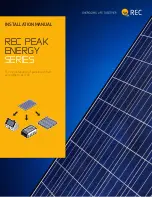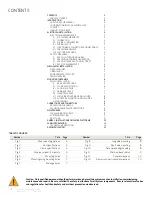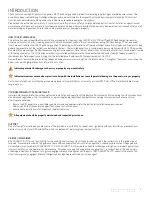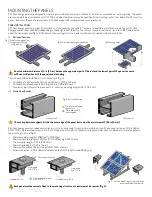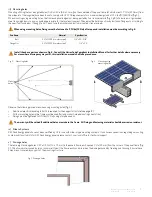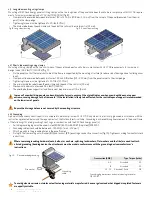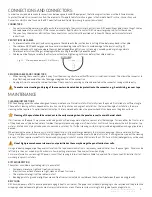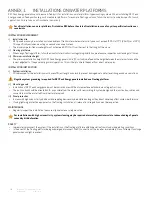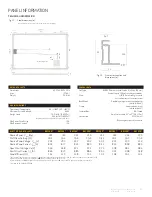
REC Peak Energy Series Installation Manual - UL 1703
Ref: NE-06-03-M
Rev M - 03.2014
5
panel HanDlInG
Panels should be handled with care. all warnings and instructions on the packaging should be observed. follow these guidelines when unpacking,
transporting or storing the panels:
•
record the serial numbers prior to installation and note the information in the system documentation.
•
Carry the panels using both hands and avoid using the junction box as a grip.
•
Do not allow the panels to sag or bow under their own weight when being carried.
•
Do not subject the panels to loads or stresses e.g., leaning or placing heavy objects on them.
•
Do not stand on the panels or cause impact through dropping them.
•
keep all electrical contacts clean and dry.
•
store panels in a dry and properly ventilated room.
•
Do not apply force to the backsheet.
•
avoid using sharp or pointed objects if panels require marking.
•
Never apply paints, adhesives or detergents to the back of the laminate.
•
Do not use any solar panel that is damaged or been tampered with.
•
Never attempt to disassemble the panels.
If the panel front glass is broken or laminate back sheet is damaged, it can expose personnel to hazardous voltages.
MeCHaNiCal iNsTallaTioN
fIRe GuIDelInes
reC Peak energy panels have a Class C, Type 2 fire classification. The fire rating of this panel is only valid when mounted in the manner specified in
these mechanical mounting instructions. utilize the following fire safety guidelines when installing reC Peak energy panels:
•
Check with local authorities for fire safety guidelines and requirements for any building or structure on to which the panels will be installed.
•
The system design should ensure that it can be easily accessed in the event of a building fire.
•
Check with local authorities for applicable regulations concerning setbacks or other placement restrictions that may apply for roof-mounted
arrays.
•
The use of DC ground fault interrupters is recommended. This may also be required by local and national codes.
•
all electrical appliances are a fire risk. The panel should therefore be mounted over a fire retardant roof covering rated for the application
and a suitable distance of 4 in between the panel and the mounting surface, allowing free circulation of air beneath the panels, should be
respected at all times.
oRIentatIon
To maximize system output, panels should be installed at the optimum orientation and tilt angle. The specifics of this depend on location and can
be calculated by a qualified system designer. a lower angle of panel installation increases the requirement for regular cleaning.
The optimal mounting position of panels results in the sun’s rays falling perpendicular (i.e. at 90°) to the surface. all panels in a string should,
wherever possible, have the same orientation and tilt to ensure the system does not underperform due to mismatched outputs.
The panels must not be exposed to artificially concentrated sunlight.
enVIRonmental faCtoRs
reC Peak energy panels are designed to provide decades of durable and stable output. operating temperatures should be between -40 and
185°f (-40 and +85°C).
The panels are not suitable for installation in potentially hazardous locations nor should they be installed in the following locations:
•
Near sources of flammable gases or vapors
•
Near open flames.
•
under water or in water features.
•
where exposed to sulfur e.g. near sulfur springs or volcanoes.
•
where the panels may be exposed to harmful chemicals.
Ensure panels are not exposed to direct contact with salt water/spray and avoid installation in areas subject to high salt mist content
e.g. coastal areas.
For installations on water e.g., floating pontoons, see Annex 1 at the rear of this manual.

